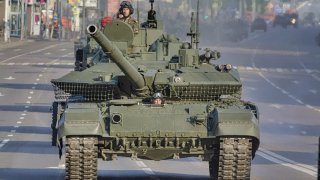Putin Is Freaked: Ukraine's Kursk Offensive Has Surprised the World
Ukraine's surprise offensive into Russia's Kursk region, involving up to 10,000 troops, has dramatically shifted the dynamics of the ongoing conflict. The operation, which captured over 1,000 square kilometers and 82 settlements, aims to force Russia to realign its forces, drawing them away from Ukrainian frontlines.
Summary and Key Points: Ukraine's surprise offensive into Russia's Kursk region, involving up to 10,000 troops, has dramatically shifted the dynamics of the ongoing conflict. The operation, which captured over 1,000 square kilometers and 82 settlements, aims to force Russia to realign its forces, drawing them away from Ukrainian frontlines.
-The psychological impact on both Ukrainian and Russian populations is significant, with Russia's inability to defend its territory undermining President Putin's standing.
-While the offensive doesn't alter Russia's numerical advantage, it signals a momentum shift in the war, potentially affecting the longevity of Western support for Ukraine.
Ukraine's Bold Offensive: How a Surprise Incursion into Russia is Changing the War
After more than two years on the defensive, Ukrainian forces have flipped the script, pouring over the Russian border and seizing control of more than 1,000 square kilometers of territory in a week. And unlike Ukraine’s previous and usually short-lived raids across the border, this time, Ukrainian forces are settling in for a fight, fortifying defensive positions throughout the occupied Kursk region in what Ukrainian officials are calling a “buffer zone” to protect against continued airstrikes launched into Ukraine from the area.
This surprise offensive went on for days before Ukrainian officials shed any light on its objectives. We now know that the theory posited by many analysts throughout the week – that this incursion is meant to force a realignment of Russian forces after months of steady but grinding advances deeper into Ukrainian territory – is true.
Behind the rifles of thousands of battle-hardened troops, Ukraine has taken hundreds of Russian soldiers prisoner and captured dozens of towns and villages, but the biggest blow of this ongoing offensive may be to the reputation and standing of Russian President Vladimir Putin.
How Ukraine’s invasion of Russia began
In the early morning of August 6, Ukrainian forces numbering as many as 10,000 according to some reports, launched a surprise offensive in western Russia that had been planned and staged behind a veil of complete secrecy. The attack was such a surprise that it not only took Russia’s border troops completely off guard, but Ukraine’s Western allies as well – at least if statements made by various government officials are to be believed.
Ukrainian troops and armored vehicles moved quickly, crossing the border on multiple vectors and rapidly capturing town after town. As news of the offensive reached the media, it was accompanied by social media posts uploaded by Ukrainian troops, showing them pulling Russian flags down.
In one video, vetted by the New York Times, a Ukrainian soldier can be seen standing on the shoulders of another, breaking a Russian flag off of its wooden post and tossing it aside. That video was confirmed to be taken in Sverdlikovo, just a few miles inside Russia. Another video, filmed about five miles further west in the town of Daryino, shows a similar scene, with one Ukrainian soldier tossing a Russian flag in the mud as another one flexes his muscles.
“The first days of the Ukrainian operation in the Kursk region should be assessed as very successful, although its ultimate goals remain unclear,” Ruslan Pukhov, the director of the security research group CAST out of Moscow, told the New York Times. “In moral terms, the Russian Federation has taken a powerful blow.”
This effort was arguably only successful thanks to the immense degree of secrecy surrounding it, but in hindsight, it’s beginning to get easier to see how it came together. A drone battalion from Ukraine’s 22nd Mechanized Brigade was spotted near the Russian border in July after more than a year of fighting on the front lines some 80 miles to the West. Troops from the 82nd Air Assault Brigade, last known to be fighting elsewhere in the Kharkiv region, were spotted near the border soon thereafter. Before long, troops from the 80th Air Assault Brigade seemed to join them.
This amassing of forces, despite its secrecy, didn’t go unnoticed by Russian intelligence. According to Andrei Gurulyov, a prominent member of Russia’s parliament and a former senior ranking officer in the Russian Army, a report on the buildup was submitted to Russian leadership nearly a month before the assault.
“But from the top came the order not to panic, and that those above know better,” Gurulyov acknowledged on Russian State Television.
Progress comes with a cost
While the attack has since become something of a morale lightning rod for the embattled Ukrainian population, for many of the troops taking their fight for survival to Russian soil, the combat was just like any other day in this conflict.
“Grenades and mortars look the same wherever you are,” explained a 43-year-old Ukrainian soldier named Ivan, who’s fighting in Russia.
Ivan’s experiences over the past few weeks serve as a grim reminder that even this successful operation has come at a significant cost. He and his unit were advancing into Russian territory at an average of an astonishing 10 kilometers (6.2 miles) a day, fighting their way across open fields and railway lines, and rotating in fresh troops under cover of darkness as each night fell. But after three days of fighting off their back foot, Russian forces finally started to get their bearings and unleashed an onslaught of air-dropped glide bombs onto the Ukrainian forces on the third night, despite the obvious collateral damage done to Russian territory.
These glide bombs have proven highly effective for Russian forces in recent months. They’re similar in function to America’s own JDAM-ERs, made up of satellite guidance kits and expandable glide-wings mounted on inexpensive gravity bombs. They’re exceedingly difficult to intercept, offer a high degree of precision, and can be dropped from 40 miles out.
Ivan’s unit instantly lost a dozen men when the first wave of bombs hit, with several others injured.
“Everything was burning. Arms here, legs there,” Ivan recounted.
Ivan himself took shrapnel to the groin and chest, forcing him to be evacuated back to Ukraine for medical treatment and allowing him to share a few scant details about the ongoing operation with journalists from The Economist. But after nearly 30 months of fighting for its survival, Ukraine is no stranger to loss. Even as Russian glide bombs rained down, the offensive progressed – and the following day, on August 10 – some Ukrainian units had pressed a full 40 kilometers (about 25 miles) into Russia, rapidly approaching the city of Kursk, which serves as the capital of the Kursk Oblast.
More Ukrainian soldiers have shined some light on how Ukraine has managed to capture more territory in a week than Russia has in months: A 28-year-old paratrooper from Ukraine’s 33rd Brigade named Angol made it 30 kilometers (a bit more than 18 miles) into Russia before being injured – he isn’t sure if he was hit by artillery, a glide bomb, or even friendly fire, such is the haze of battle on the front lines.
According to Angol, even amid the heavy fighting, Russian troops were on the run, enabled by covering airstrikes and artillery fire as they fled their defensive positions, abandoning equipment, weapons, and ammunition as they ran.
It seems the Russian troops defending the border believed the red line drawn by Putin, which has seen Western governments disallow the use of their weapon systems to attack Russian territory, would be enough to insulate them from the fighting. As thousands of battle-hardened Ukrainian troops tore through the region, they seemed to continue taking Russians by surprise even days into the offensive.
“We sent our most combat-ready units to the weakest point on their border,” an unnamed member of Ukraine’s general staff deployed to the region told the press. “Conscript soldiers faced paratroopers and simply surrendered.”
And surrender they did. By August 13, seven days into Ukraine’s surprise invasion, Ukrainian President Volodymyr Zelenskyy announced that 74 Russian settlements were now under Ukrainian occupation and that “hundreds” of Russian troops had surrendered. By the following day, the number of Russian towns and villages inside of Ukrainian control had expanded once again, to 82.
In one engagement, Ukrainian forces captured 102 soldiers out of Russia’s 488th Guards Motorized Rifle Regiment at once.
“They captured and cleared a sprawling, concrete and well-fortified company stronghold from all sides – with underground communications and personnel accommodation, a canteen, an armoury and even a bathhouse,” an unnamed source told Reuters.
According to Russia’s state media, more than 132,000 Russian civilians have now fled their homes in the Kursk region to avoid the fighting.
“Russia brought war to others, and now it is coming home,” Zelensky said in his speech.
It’s worth noting that despite the hesitation of Western leaders to allow Ukraine to take the fight onto Russian soil, it’s evident that this offensive has involved the widespread use of American-supplied vehicles, arms, and munitions – in what some argue could be seen as a violation of yet another of Putin’s “red lines.” However, U.S. officials don’t see it that way. With countless long-range strikes launched into Ukrainian territory from the Kursk region, both Ukrainian and American officials have deftly taken to calling the offensive a “self-defense” action.


